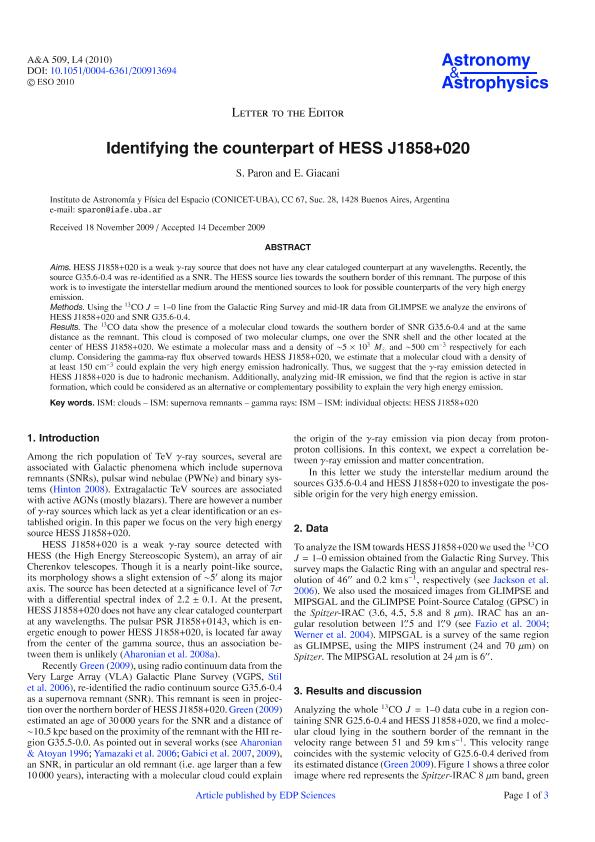Mostrar el registro sencillo del ítem
dc.contributor.author
Paron, Sergio Ariel

dc.contributor.author
Giacani, Elsa Beatriz

dc.date.available
2017-06-28T18:43:13Z
dc.date.issued
2010-01
dc.identifier.citation
Paron, Sergio Ariel; Giacani, Elsa Beatriz; Identifying the counterpart of HESS J1858+020; EDP Sciences; Astronomy and Astrophysics; 509; L4; 1-2010; 1-3
dc.identifier.issn
0004-6361
dc.identifier.uri
http://hdl.handle.net/11336/19026
dc.description.abstract
Aims: HESS J1858+020 is a weak γ-ray source that does not have any clear cataloged counterpart at any wavelengths. Recently, the source G35.6-0.4 was re-identified as a SNR. The HESS source lies towards the southern border of this remnant. The purpose of this work is to investigate the interstellar medium around the mentioned sources to look for possible counterparts of the very high energy emission. <br /> Methods: Using the <sup>13</sup>CO J=1-0 line from the Galactic Ring Survey and mid-IR data from GLIMPSE we analyze the environs of HESS J1858+020 and SNR G35.6-0.4. <br /> Results: The <sup>13</sup>CO data show the presence of a molecular cloud towards the southern border of SNR G35.6-0.4 and at the same distance as the remnant. This cloud is composed of two molecular clumps, one over the SNR shell and the other located at the center of HESS J1858+020. We estimate a molecular mass and a density of ˜ 5 × 10<sup>3</sup> M_ȯ and ~500 cm<sup>-3</sup> respectively for each clump. Considering the gamma-ray flux observed towards HESS J1858+020, we estimate that a molecular cloud with a density of at least 150 cm<sup>-3</sup> could explain the very high energy emission hadronically. Thus, we suggest that the γ-ray emission detected in HESS J1858+020 is due to hadronic mechanism. Additionally, analyzing mid-IR emission, we find that the region is active in star formation, which could be considered as an alternative or complementary possibility to explain the very high energy emission.
dc.format
application/pdf
dc.language.iso
eng
dc.publisher
EDP Sciences

dc.rights
info:eu-repo/semantics/openAccess
dc.rights.uri
https://creativecommons.org/licenses/by-nc-sa/2.5/ar/
dc.subject
Ism:Clouds
dc.subject
Ism:Supernova Remnants
dc.subject
Gamma Rays: Ism
dc.subject
Ism:Individual Objects:Hess J1858+020
dc.subject.classification
Astronomía

dc.subject.classification
Ciencias Físicas

dc.subject.classification
CIENCIAS NATURALES Y EXACTAS

dc.title
Identifying the counterpart of HESS J1858+020
dc.type
info:eu-repo/semantics/article
dc.type
info:ar-repo/semantics/artículo
dc.type
info:eu-repo/semantics/publishedVersion
dc.date.updated
2017-06-26T19:49:07Z
dc.journal.volume
509
dc.journal.number
L4
dc.journal.pagination
1-3
dc.journal.pais
Francia

dc.journal.ciudad
Paris
dc.description.fil
Fil: Paron, Sergio Ariel. Consejo Nacional de Investigaciónes Científicas y Técnicas. Oficina de Coordinación Administrativa Ciudad Universitaria. Instituto de Astronomía y Física del Espacio. - Universidad de Buenos Aires. Facultad de Ciencias Exactas y Naturales. Instituto de Astronomía y Física del Espacio; Argentina
dc.description.fil
Fil: Giacani, Elsa Beatriz. Consejo Nacional de Investigaciónes Científicas y Técnicas. Oficina de Coordinación Administrativa Ciudad Universitaria. Instituto de Astronomía y Física del Espacio. - Universidad de Buenos Aires. Facultad de Ciencias Exactas y Naturales. Instituto de Astronomía y Física del Espacio; Argentina
dc.journal.title
Astronomy and Astrophysics

dc.relation.alternativeid
info:eu-repo/semantics/altIdentifier/doi/http://dx.doi.org/10.1051/0004-6361/200913694
dc.relation.alternativeid
info:eu-repo/semantics/altIdentifier/url/https://arxiv.org/abs/0912.2669
dc.relation.alternativeid
info:eu-repo/semantics/altIdentifier/url/https://www.aanda.org/articles/aa/full_html/2010/01/aa13694-09/aa13694-09.html
Archivos asociados
